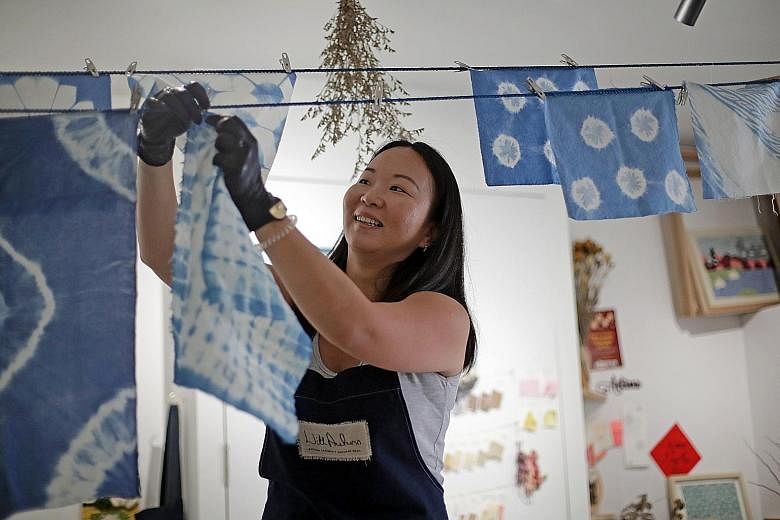Tie-dyed fabric is often associated with hippie-esque youths, but Mrs Autumn Brown describes her shibori workshops as tie-dyeing for adults.
Shibori is a Japanese dyeing technique that Mrs Brown, 33, teaches at her studio, WithAutumn.
Students use everyday objects to create patterns on a khadi cotton scarf, a type of fabric from India that is hand-woven on traditional looms with hand-spun cotton yarn.
Tying marbles into the fabric with rubber bands produces wavy, doughnut-like circles. Clothespins create little squares, while opaque circles clipped to the scarf create polka dots.
The possibilities are endless. Mrs Brown provides templates for nervous learners and two smaller squares of fabric for them to practise on before they dye the actual scarf.
The magic happens when students dip the fabric into a large vat of indigo dye. In a technique known as resist-dyeing, only the exposed parts of the fabric will take on a blue hue, which deepens with multiple soaks.
The dye - warm, organic and metallic-smelling - is made from the leaves of the indigofera plant. Farmers in Indonesia's Flores grow the plant and process its leaves into a paste, which Mrs Brown imports.
At her studio near Ann Siang Hill, she watches over the fermentation process, similar to that of kombucha or cheese.
Like any living thing, the dye must be cared for daily. Mrs Brown feeds it fruit sugars such as banana skins, maintains an alkaline environment and takes dye swatches to check on its "health".
"Indigo is among a huge array of plants that can be used for natural dyeing. It's a great way to learn about the process and get creative," says Mrs Brown, who was born in Singapore and is married to a Briton.
She began running WithAutumn from a co-working space in 2018 and moved to her current premises last year. The studio also offers classes on tapestry weaving, block printing and needle punching.
Although corporate bookings have fallen since the outbreak of Covid-19, sales of her DIY needle punch and weaving kits have remained healthy.
She is currently producing tutorial videos on how to do indigo dyeing at home and will launch a DIY indigo kit in about a month.
She says: "I want to combine the traditional technique of indigo dyeing, which has been used since the eighth century, with modern designs and products that people can incorporate into their everyday lives."
A natural indigo dyeing and shibori workshop, for up to four participants, costs $169 a person.
For more information, go to withautumn.com


